Table of Contents
As a result of an agreement concluded on March 11, 1930, between the Polish company "Zegluga Polska" and the Danish East Asiatic Company Ltd., a limited company was formed, called Polish Transatlantic Shipping Company, Limited -- Gdynia-America Line, having its seat in Poland. The purpose of the newly-formed company was the operation of a regular passenger-cargo service to North American ports.
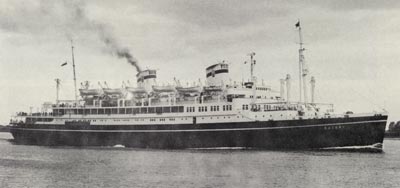
M.S. BATORY. On a cloudy fall day approaching Vercherres, Quebec. September 17, 1962
On October 31, 1934, the company took the name of Gdynia America Shipping Lines Co., Ltd., in abbreviation: GAL. To begin with the company had three passenger vessels taken over from the partner. These were the S.S. "Polonia", S.S. "Pulaski" and S.S. "Kosciuszko" totalling 20,697 GTR and 18,650 TDW. In order to accomplish its operational task, the company endeavoured to increase and modernise its tonnage by acquiring new ships. On November 29, 1933, GAL signed an agreement with an Italian yard, Cantieri Riuniti dell Adriatico in Monfalcone for the building of two passenger vessels for the North American Line. The building of the first vessel, to be named M.S. "Pilsudski" was started on March 1, 1934, and completed on August 22, 1935. The second ship, the M.S. "Batory" was launched on July 3, 1935, sailing on her first voyage to New York on May 18, 1936. The acquisition of these two ships enabled the company to expand its passenger policy in the North Atlantic region, to compete successfully with other lines and to achieve good results from its liner service and organised cruises.
Gradually GAL expanded its activities to include the Palestine Line (1933-1938), South American ports (1936) and the Mexican Gulf (1936). Further investments arose from the need to have appropriate vessels for the service offered by the company.
The M.S. "Sobieski" was built at the English yard of Swan, Hunter & Wigham Richardson and the M.S. "Chrobry"at the Danish yard of Nakskow Skinsvaerf -- both in 1939 and both for the South American service. An order for two cargo vessels was placed with the Gdansk Yard. Both these vessels, the M.S. "Bielsko" and the M.S. "Lodz", were taken over by the Germans in September, 1939. For the South American cargo service, GAL purchased two second-hand vessels, which, as the M.S. "Stalowa Wola" and the M.S. "Morska Wola", were put into service. After the sale of the S.S. "Polonia" on September 1, 1939, GAL's fleet consisted of 8 vessels- totalling 70,696 GRT and 46,202 TDW.
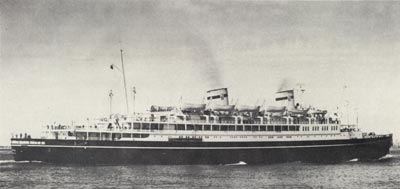
M.S. BATORY. Heading downriver, having passed the quaint town of Vercherres, Quebec. October 10, 1962
GAL was increasing its activities in ocean-going cargo service. This action however, was held up through lack of appropriate tonnage and finance. This arose from the general situation in which maritime economy found itself in the years before the outbreak of the Second World War. At this time the Polish fleet consisted mainly of passenger vessels. In the second half of 1939 passenger tonnage amounted to 63,000 GRT, whereas the cargo fleet amounted to only 56,000 GRT. The cargo fleet was clearly under-developed.
GAL's further development, and that of other shipping companies in Poland, was interrupted owing to the outbreak of the Second World War and the German occupation of Poland. The Polish companies carried on abroad, having their base in London.
Losses incurred by Polish shipping companies during the second world war amounted to 19 ships, totalling 65,345 GRT and 73,523 TDW. Direct personnel losses amounted to 66 people. GAL incurred the greatest losses. In addition to three of their own vessels (the M.S. "Pilsudski". M.S. "Chrobry" and S.S. "Paderewski"), two other ships were lost (the M.S. "Kinross and M.S. "Dumfries"), purchased through GAL (London) Ltd. Both these vessels, operating under British flag, were owned by GAL as sole shareholder in GAL (London) Ltd. , formed in 1941.
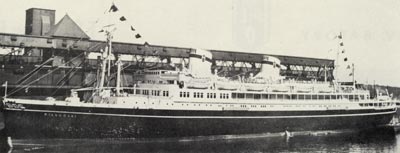
M.S. PILSUDSKI. Montreal, Quebec, Sept. 20, 1936. View taken from deck of C.P. S.S. Duchess of Atholl.
During the years between 1940 and 1945 GAL endeavoured to replace this tonnage, and finally acquired 8 ships; 3 were lost, so that 5 were left, totalling 34,238 GRT. On January 1, 1945, GAL owned 11 ships, totalling 79,223 GRT and 83,272 TDW. From 1944 GAL also operated vessels belonging to Zegluga Polska and Polsko-Brytyjskie Towarzystwo Okretowe. At the end of 1945 the total tonnage operated by GAL amounted to 24 ships, 102,241 GRT and 117,078 TDW.
During the Second World War the majority of Polish tonnage was chartered by the British Government. GAL's vessels being in British Government charter took part in all the major operations which required merchant ships.
During the Norwegian campaign, the M.S. "Chrobry" was sunk by enemy aircraft near Harstad. During the threat of German invasion of the British Isles, the M.S. "Batory" was carrying English children to Australia thus gaining much popularity and renown in Western Europe, In 1942 the S.S. "Pulaski" was speeding to the assistance of Singapore. Unfortunately, however, the garrison was compelled to surrender to the enemy before she was able to reach the port with supplies.
During the invasion of Madagascar in May, 1942, the M.S. "Sobieski" was the flag ship. There are many other cases which can illustrate the role played by Polish ships during wartime operations and the heroism showed by Polish crews. These ships were able to fight uneven battles with the enemy, come to the aid of others, very often dangering their own safety. In October, 1943, the S.S. "Narvik" saved 1,022 survivors from the Orcades, which had been torpedoed by a German U-boat. The M.S. "Morska Wola" and "Stalowa Wola" operated a regular service between Manchester and New York.
During the Second World War, enlivened and useful activities were developed by the Transport Union. This Union, under very difficult staff conditions, where there were all sorts of unfavourable influences, was able to achieve much better social conditions for crews sailing with the Polish Merchant fleet. The Union also did much regarding the return of the Polish fleet to Poland, in spite of opposition from Polish groups in London. An expression of the changes occurring in the environment of officers and crews was the majority decision to return to Poland.
Between 1945 and 1950 GAL was fulfilling the tasks set to the merchant fleet in different social and economic conditions. Gradually socialist elements became more and more important in the company, following changes in the structure of maritime economy.
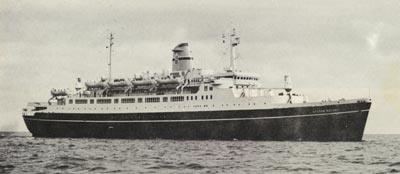
S.S. STEFAN BATORY. Completely refitted at Gdansk.
After 1945 the dominating task of the Polish Merchant Fleet, administered by GAL, was to ensure service to Polish ports and to pacify the needs of Polish foreign and transit trade with friendly countries. The development of the merchant fleet was strictly dependent of the situation and policy in foreign trade.
The main burden was placed on the development of liner services. This arose for several reasons, the chief one being to secure service for Polish foreign trade exchange, which was renewing former and traditional trade relations with European countries and with America, and then making new contacts with the Far East. The Polish Merchant Fleet was now developing a period of successful progressive shipping in the Far East areas. On June 22, 1949 the "General Walter" inaugurated a regular service to India. From that time on, Polish ships called regularly at more and more ports on this Far Eastern route. In 1950 this line was extended to ports of the Chinese People's Republic.
On January 1, 1951, two nationalised shipping companies were brought into being: Polish Ocean Lines in Gdynia, whose main task was the operation of regular ocean and European lines, and ocean tramping: Polish Steamship Company in Szczecin, whose main task was the operation of irregular short-sea trade and regular lines on the Baltic.
By December 31, 1967, the Polish Merchant Fleet reached a total of 228 ships, totalling 1,618,495 TDW. This fleet operates on 32 regular lines, and in ocean tramping Polish ships sail to practically every port in the world. GAL's participation in reaching this achievement will go down in the annals of its history.
With the Second War over, the M.V. Batory was returned to her owners by the British Ministry of Transport. In 1946 she was enroute to a shipyard in Antwerp, to be completely refitted for passenger service. Unfortunately while still in the yard at Antwerp she was severely damaged by fire, thus delaying her return to service. Finally in 1947 she set sail from Antwerp, looking just as graceful as the day she was built.
From 1947 to 1951 the M.S. Batory was a regular visitor to the Port of New York, from where she ran to Southampton, Copenhagen and Gdynia. After about four years of bucking the North Atlantic, she was withdrawn in the Fall of 1951, and shortly thereafter commenced operation on a new service from Southampton, Karachi and Bombay via the Suez Canal.
It was during the Suez crisis of 1956, and the eventual closing of the canal, which forced the Gdynia America Line to terminate their passenger service from the United Kingdom to India, after some five years of operation.
While the M.S. Batory made her first voyage to Montreal on September 5th, 1957, her sistership, the M.S. Pilsudski, preceded her into the Port of Montreal by some twenty-one years, as it was back in Sept. 20, 1936, when she arrived from New York on a seven day cruise. Unfortunately, the M.S. Pilsudski, which was named after a Polish General, had a very short life; while serving with the Allied forces she was torpedoed by a U-Boat on November 26th, 1939, off the North West Coast of England.
For some eleven years the M.S. Batory plied the North Atlantic run, Montreal and Quebec in the summer, and in the winter months usually with hundreds of new Canadians disembarking in cold and bleak Halifax. On December 4th, 1968, she set sail from Montreal with 304 passengers aboard on her final voyage. During the eleven years she was in service to Montreal and Halifax she made 107 round trips, and carried a total of 136,000 passengers, and 110,000 tons of cargo. While her active sea career lasted some thirty-two years and eight months, she is now a floating hotel at Gdynia, a ship as good as the Batory may last another thirty-two.
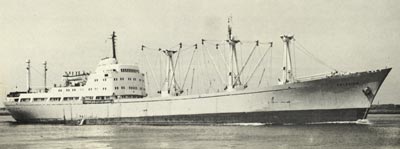
M.S. POLANCIA. One of P.O.L. modern cargo liners passing Rozenburg, Holland. July 4, 1969 inbound to Rotterdam.
In 1968 the Polish Ocean Lines purchased the S.S. Maasdam from the Holland America Line to replace the M.S. Batory. The S.S. Maasdam was drydocked at the Gdansk Ship-Repair Yard. She was completely refitted inside and out, and now bears the proud name S.S. Stefan Batory, and like the old Batory will be on the North American run to Montreal and Quebec in the summer, however the winter months will find her cruising the Caribbean. The Stefan Batory left Gdynia on April 11th, 1969, on her maiden trip to Montreal, and is now a regular caller there, however Rotterdam has been added to her Ports of Call.
During the spring of 1969 Polish Ocean Lines announced plans for an impending service from Gdynia and Continental European ports to Montreal and the Great Lakes, with ships to be built especially for this service. The prototype of this vessel is designated class B446. M.V. Zakopane of some 7,500 tons DWT, is ice strengthened, stern anchor, and fully equipped for Seaway use. This service will commence when authorization is received for approval of this route.
Built April 1936 by C.R.D. Adriatico.
S. S. STEFAN BATORY (Ex Maasdam)
Built July 1952 by V. Wilton-Fijennord
Rebuilt. 1968 by Gdansk Ship-Repair Yard.
Previous
Return to Home Port or Toronto Marine Historical Society's Scanner
Reproduced for the Web with the permission of the Toronto Marine Historical Society.